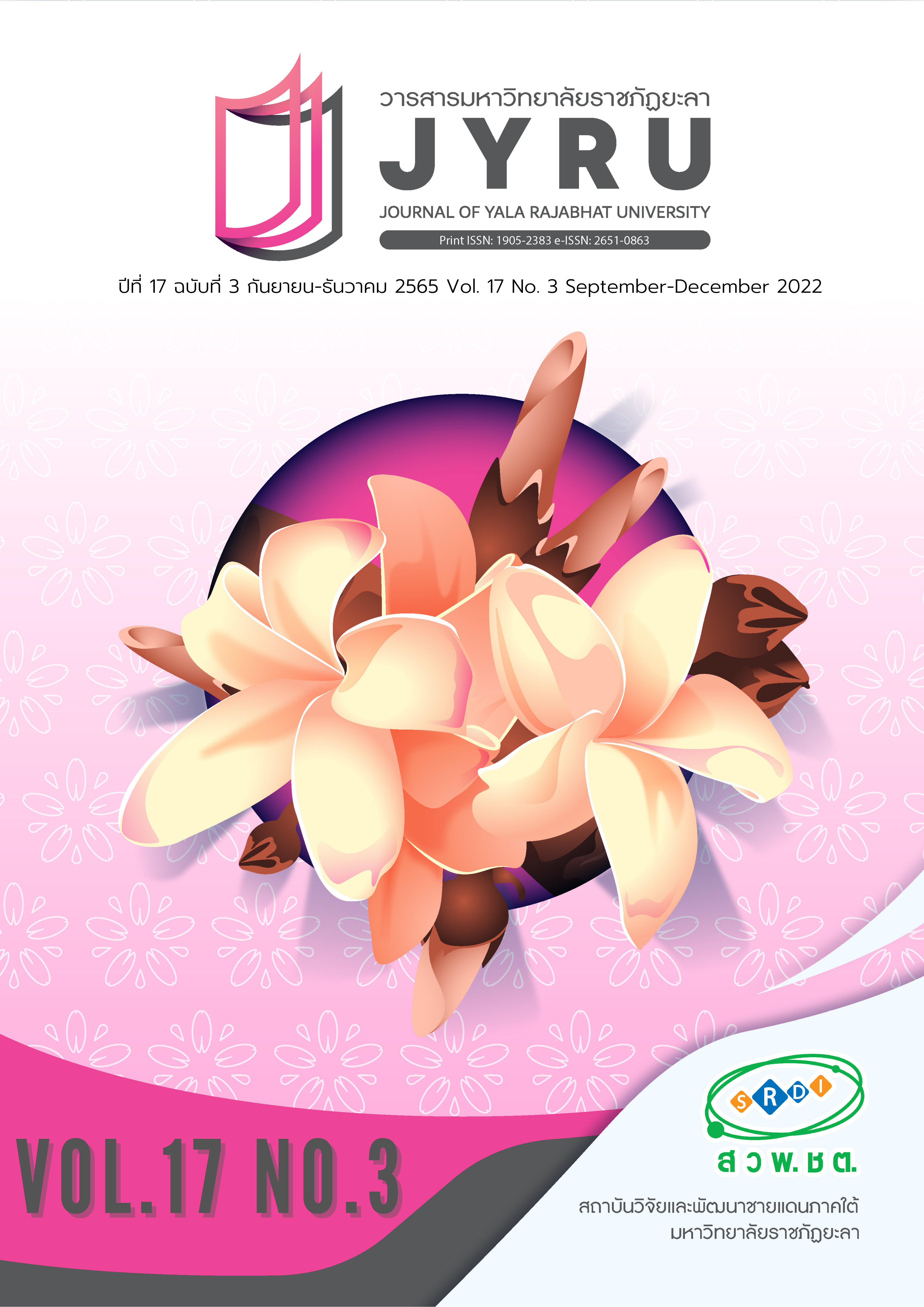การวิเคราะห์องค์ประกอบเชิงยืนยันของการตัดสินใจซื้อเกมออนไลน์บน Platform Steam ของผู้ใช้บริการในเขตกรุงเทพมหานคร
Main Article Content
บทคัดย่อ
การที่จะทำให้ Platform Steam ครองตลาดเกมออนไลน์และเป็นที่นิยมในกลุ่มผู้เล่นเกม ต้องมีแผนกลยุทธ์ในด้านการตลาดออนไลน์ เทคโนโลยีของระบบเกม และ จิตวิทยาของผู้เล่นเกมให้มีความเหมาะสม จึงวิจัยโดยมีวัตถุประสงค์เพื่อวิเคราะห์องค์ประกอบเชิงยืนยันการตัดสินใจซื้อเกมออนไลน์บน Platform Steam ของผู้ใช้บริการในเขตกรุงเทพมหานคร และเพื่อตรวจสอบความสอดคล้องของโมเดลกับข้อมูลเชิงประจักษ์ เก็บข้อมูลกลุ่มตัวอย่างจากผู้ใช้บริการ ในเขตกรุงเทพมหานคร จำนวน 400 คน โดยการเลือกแบบเจาะจง ใช้แบบสอบถามเก็บข้อมูล วิเคราะห์ข้อมูลด้วยสถิติพื้นฐานประกอบด้วย ค่าความถี่ ร้อยละ ค่าเฉลี่ย และ ส่วนเบี่ยงเบนมาตรฐาน ผลการวิจัยพบว่า การวิเคราะห์โมเดลองค์ประกอบเชิงยืนยันอันดับที่สองการตัดสินใจซื้อเกมออนไลน์บน Platform Steam ทั้ง 3 องค์ประกอบมีความสอดคล้องกับข้อมูลเชิงประจักษ์ ซึ่งมีค่า χ2 เท่ากับ 18.072 ค่า df เท่ากับ 17 ค่า χ2/df เท่ากับ 1.063 ค่า p-Value เท่ากับ 0.384 ค่า GFI เท่ากับ 0.992 ค่า AGFI เท่า 0.968 ค่า CFI เท่ากับ 1.000 ค่า NFI เท่ากับ 0.993 ค่า RMR เท่ากับ 0.010 ค่า RMSEA เท่ากับ 0.013 และ ค่า TLI เท่ากับ 0.999 ผ่านเกณฑ์สอดคล้องในระดับดี และมีค่า AVE เท่ากับ 0.750 ค่า CR เท่ากับ 0.899 ซึ่งมีค่าความเที่ยงตรงภายในและค่าความเชื่อมั่นสูง โดยองค์ประกอบด้านแรงจูงใจ การยอมรับเทคโนโลยี และ ส่วนประสมทางการตลาดออนไลน์ มีค่าสัมประสิทธิ์การพยากรณ์ (R2) ที่อธิบายการตัดสินใจซื้อเกมออนไลน์บน Platform Steam ได้ คิดเป็นร้อยละ 86 ร้อยละ 77 และ ร้อยละ 63 ตามลำดับ ทั้งนี้ผู้ประกอบการและหน่วยงานที่เกี่ยวข้องควรให้ความสำคัญในการพัฒนาและส่งเสริมอุตสาหกรรมเกมออนไลน์ให้มีความมั่นคง จากงานวิจัยควรนำองค์ประกอบด้านแรงจูงใจ การยอมรับเทคโนโลยี และ ส่วนประสมทางการตลาดออนไลน์มาใช้ให้มากยิ่งขึ้น
Article Details

อนุญาตภายใต้เงื่อนไข Creative Commons Attribution-NonCommercial-NoDerivatives 4.0 International License.
บทความ ข้อมูล เนื้อหา รูปภาพ ฯลฯ ที่ได้รับการเผยแพร่ในวารสารมหาวิทยาลัยราชภัฏยะลานี้ ถือเป็นลิขสิทธิ์ของวารสารมหาวิทยาลัยราชภัฏยะลา หากบุคคลหรือหน่วยงานใดต้องการนำทั้งหมดหรือส่วนหนึ่งส่วนใดไปเผยแพร่ต่อหรือกระทำการใดๆ จะต้องได้รับอนุญาตเป็นลายลักษณ์อักษรจากวารสารมหาวิทยาลัยราชภัฏยะลาก่อนเท่านั้น
เอกสารอ้างอิง
Asyraf, W.M., & Afthanorhan, B.W. (2013). “A comparison of partial least square structural equation modeling (PLS-SEM) and covariance based structural equation modeling (CB-SEM) for confirmatory factor analysis.” International Journal of Engineering Science and Innovative Technology (IJESIT), 2(5), 198–205.
Davis, F. D. (1989). Perceived usefulness, perceived ease of use, and user acceptance of information technology. MIS Quarterly, 13(3), 319-340.
Deelers, S., & Rattanapongpun, S. (2018). The factors that influence consumer with purchasing decisions process of e-commerce market niches. Veridian E- Journnal, Silpakorn University, 11(1), 2404- 2424. (in Thai).
Digital Economy Promotion Agency Digital. (2021). Digital content series: Game. [Online]. Retrieved May 11, 2021, from https://www.depa.or.th/th/article-view/2-digital-content-series-game (in Thai).
Hair, J. F. (Jr.), Hult, G. T. M., Ringle, C. M., & Sarstedt, M. (2014). A primer on partial least squares structural equation modeling (PLS-SEM). California, CA: Sage Publications.
Jiang, G., Peng, L., & Liu, R. (2015). Mobile game adoption in China: The role of TAM and perceived entertainment, cost, similarity and brand trust. International Journal of Hybrid Information Technology, 8(4), 213–232.
Hsiao, K. L., & Chen, C. C. (2016). What drives in-app purchase intention for mobile games? An examination of perceived values and loyalty. Electronic commerce research and applications, 16, 18-29.
Kelloway, E.K. (2015). Using mplus for structural equation modeling; A researcher’s guide. CA: Sage Publications.
Koonce, G. L., & Kelly, M. D. (2014). Analysis of the reliability and validity of a mentor's assessment for principal internships. Education Leadership Review, 15(2), 33-48.
Kotler, P., & Keller, K. L. (2016a). A framework for marketing management. (6th ed.). England: Pearson Education Limited.
Lhuangtep, P., & Pasunon, P. (2014). Factors affecting goods and services purchasing decision through e-commerce of Silpakorn University Petchaburi Campus students. Veridian E-Journnal, Silpakorn University, 7(2), 621-638. (in Thai).
Liu, Y., & Li, H. (2011). Exploring the impact of use context on mobile hedonic services adoption: An empirical study on mobile gaming in China. Computers in Human Behavior, 27(2), 890-898.
National Statistical Office. (2021). Number and percentage of household have access to internet by region and province: 2010 - 2019. [Online]. Retrieved May 11, 2021, from: http://statbbi.nso.go.th/staticreport/page/sector/th/16.aspx (in Thai).
Nongyai, P., & Wiroonrath, S. (2019). Guidelines for using marketing mix and social media marketing of small online businesses: a case study of fashion products in the ECC region. Journal of Global Business Review, 21(2), 23-39.
Pei-Shan, W. & Hsi-Peng, L. (2014). Why do people play mobile social games? An examination of network externalities and of uses and gratifications. Internet Research, 24(3), 313-331
Rovai, A. P., Baker, J. D., & Ponton, M. K. (2014). Social sci. research design and statistics: A practitioner's guide to research methods and IBM SPSS analysis. Chesapeake, VA: Watertree Press LLC.
Ryan, R. M., & Deci, E. L. (2000). Self-determination theory and the facilitation of intrinsic motivation, social development, and well-being. American Psychologist, 55(1), 68–78.
Soosakulsing, W., & Rurkwararuk, W. (2020). Online marketing mix factors affecting the decision to buy fashion clothes through e-commerce website in Mueang, Phitsanulok Province. Economics and Business Administration Journal Thaksin University, 12(1), 99-118. (in Thai).
Thansettakij. (2021). Overview of the game market in 2020. [Online]. Retrieved May 11, 2021, from: https://www.thansettakij.com/infographic/928 (in Thai).
Yen, Y. S., & Wu, F. S. (2016). Predicting the adoption of mobile financial services: The impacts of perceived mobility and personal habit. Computers in Human Behavior, 65, 31-42.


